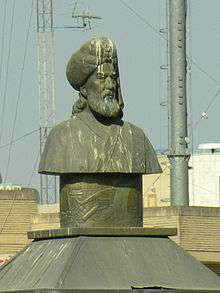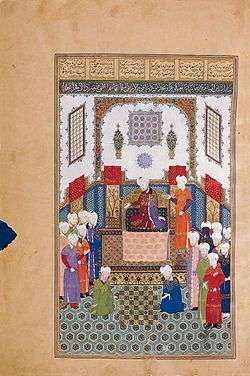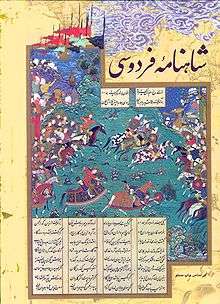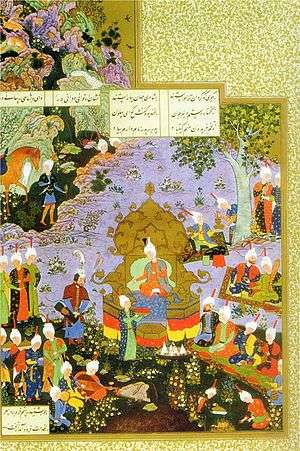Bozorgmehr
| Bozorgmehr | |
|---|---|
 | |
| Native name | Wuzurgmihr ī Bōkhtagān |
| Born | Sasanian Empire |
| Died | Sasanian Empire |
| Cause of death | Execution |
| Other names | Burzuya, Burzmihr, Dadmihr, Dadburzmihr |
| Occupation | vizier, Grand vizier, spahbed |
| Parent(s) |
|
Bozorgmehr-e Bokhtagan (Middle Persian: Wuzurgmihr ī Bōkhtagān), also known as Burzmihr, Dadmihr and Dadburzmihr,[1] was an Iranian nobleman from the Karen family,[2] who served as minister of the Sasanian emperor Kavadh I (498-531), and later as Grand Vizier under his son Khosrow I (reign 531–579), and then as spahbed under Hormizd IV. According to Persian and Arabic sources, he was a man of "exceptional wisdom and sage counsels" and later became a characterisation of the expression. His name appears in several important works in Persian literature, most notably in the Shahnameh.[3] The historian Arthur Christensen has suggested that Bozorgmehr was the same person as Borzuya, but historigraphical studies of post-Sasanian Persian literature, as well as linguistic analysis show otherwise.[3] However, the word "Borzuya" can sometimes be considered a shortened form of Bozorgmehr.[4]
Biography
Bozorgmehr is first mentioned in 498, as one of the nine sons of the powerful nobleman Sukhra.[2] After Kavadh I had reclaimed the Sasanian throne from his younger brother Djamasp, he appointed Bozorgmehr as his minister. After the death of Kavadh, his son, Khosrow I, appointed Bozorgmehr as his Grand Vizier. During the reign of Khosrow's son Hormizd IV (r. 579–590), Bozorgmehr was appointed as spahbed of Khorasan.[2] According to Ferdinand Justi, Bozorgmehr was later executed by the order of Hormizd IV.[3]

An early reference to Bozorgmehr is found in the Aydāgār ī Wuzurgmihr, in which he is called an argbed—a high-ranking title in the Sasanian and Parthian periods. Among other sources, later mention of him is made in the Shahnameh and in Al-Tha'alibi’s Ghurar and Al-Masudi’s Murūj al-Dhahab.[3]
Works
Several Middle Persian treatises were written by Bozorgmehr. Most famous is the Wizārišn ī čatrang ("Treatise on Chess"), also known as the Chatrang Nama ("Book of Chess"). As well as; Ayādgār ī Wuzurgmihr ī Bōxtagān, Ketāb al-Zabarj (the original version a commentary on Vettius Valens’s Astrologica), Ketāb Mehrāzād Jošnas ("Book of Mehrāḏar Jošnas") and the Ẓafar-nāma ("Book of Victory", a book written in Middle Persian, that was translated into New Persian by Avicenna.[3]
References
Sources
- Pourshariati, Parvaneh (2008). Decline and Fall of the Sasanian Empire: The Sasanian-Parthian Confederacy and the Arab Conquest of Iran. London, United Kingdom: I.B. Tauris. ISBN 978-1-84511-645-3.


.png)